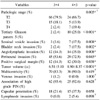Abstract
Purpose
Gleason score (GS) 7 tumors contain patterns 3 and 4 in various proportions. The clinical and pathological characteristics of patients with GS 3+4 and GS 4+3 found during a radical prostatectomy (RP) were retrospectively evaluated.
Materials and Methods
124 cases of GS 7 prostate cancer were identified between April 2004 and February 2006. None of these patients had received either preoperative hormonal therapy, including 5α-reductase inhibitors, or radiation therapy. After classifying patients with GS 7 tumors into those with GS 4+3 and GS 3+4 tumors, the two groups were compared according to various clinicopathological parameters.
Results
In total, 84 (67.7%) and 40 (32.3%) of patients had final GS of 3+4 and 4+3, respectively. A final GS of 4+3 was associated with a higher pre-biopsy level of prostate-specific antigen (p<0.001) and a higher biopsy Gleason sum (p<0.001). Also, a higher pathological T stage (p=0.005), tertiary Gleason pattern 5 (p<0.001), seminal vesicle invasion (p=0.008), bladder neck invasion (p=0.002), angiolymphatic invasion (p=0.008), perineural invasion (p=0.045), positive surgical margins (p=0.038) and larger tumor volumes (p<0.001) were associated with GS of 4+3.
Conclusions
Our results demonstrated that the statistically significant differences exist between GS 3+4 and 4+3 prostate cancers. Thus, GS 7 prostate cancers may be considered heterogeneous in their biological behaviors, and GS 7 prostate cancers with a GS of 4+3 may be considered more aggressive tumors compared to those with a GS of 3+4.
Figures and Tables
References
1. Lerner SE, Blute ML, Bergstralh EJ, Bostwick DG, Eickholt JT, Zincke H. Analysis of risk factors for progression in patients with pathologically confined prostate cancers after radical retropubic prostatectomy. J Urol. 1996. 156:137–143.
2. Blute ML, Bergstralh EJ, Iocca A, Scherer B, Zincke H. Use of Gleason score, prostate-specific antigen, seminal vesicle and margin status to predict biochemical failure after radical prostatectomy. J Urol. 2001. 165:119–125.
3. Epstein JI, Carmichael MJ, Partin AW, Walsh PC. Small high grade adenocarcinoma of the prostate in radical prostatectomy specimens performed for nonpalpable disease: pathogenetic and clinical implications. J Urol. 1994. 151:1587–1592.
4. Herman CM, Kattan MW, Ohori M, Scardino PT, Wheeler TM. Primary Gleason pattern as a predictor of disease progression in gleason score 7 prostate cancer: a multivariate analysis of 823 men treated with radical prostatectomy. Am J Surg Pathol. 2001. 25:657–660.
5. Lau WK, Blute ML, Bostwick DG, Weaver AL, Sebo TJ, Zincke H. Prognostic factors for survival of patients with pathological Gleason score 7 prostate cancer: differences in outcome between primary Gleason grades 3 and 4. J Urol. 2001. 166:1692–1697.
6. Tollefson MK, Leibovich BC, Slezak JM, Zincke H, Blute ML. Long-term prognostic significance of primary Gleason pattern in patients with Gleason score 7 prostate cancer: impact on prostate cancer specific survival. J Urol. 2006. 175:547–551.
7. Gleason DF. Classification of prostatic carcinomas. Cancer Chemother Rep. 1966. 50:125–128.
8. Gleason DF, Mellinger GT. Prediction of prognosis for prostatic adenocarcinoma by combined histological grading and clinical staging. J Urol. 1974. 111:58–64.
9. Choe GY. Kim CS, Park MS, Lee KH, Lee KS, editors. Pathology of the prostate cancer. Prostate cancer. 2000. 1st ed. Seoul: Hyomoon Publishing Inc;33–51.
10. Han M, Partin AW, Pound CR, Epstein JI, Walsh PC. Long-term biochemical disease-free and cancer-specific survival following anatomic radical retropubic prostatectomy. The 15-year Johns Hopkins experience. Urol Clin North Am. 2001. 28:555–565.
11. Sakr WA, Tefilli MV, Grignon DJ, Banerjee M, Dey J, Gheiler EL, et al. Gleason score 7 prostate cancer: a heterogeneous entity? Correlation with pathologic parameters and disease-free survival. Urology. 2000. 56:730–734.
12. Vira MA, Tomaszewski JE, Hwang WT, D'Amico AV, Whittington R, Vanarsdalen K. Impact of the percentage of positive biopsy cores on the further stratification of primary grade 3 and grade 4 Gleason score 7 tumors in radical prostatectomy patients. Urology. 2005. 66:1015–1019.
13. Chan TY, Partin AW, Walsh PC, Epstein JI. Prognostic significance of Gleason score 3+4 versus Gleason score 4+3 tumor at radical prostatectomy. Urology. 2000. 56:823–827.
14. Hattab EM, Koch MO, Eble JN, Lin H, Cheng L. Tertiary Gleason pattern 5 is a powerful predictor of biochemical relapse in patients with Gleason score 7 prostatic adenocarcinoma. J Urol. 2006. 175:1695–1699.
15. McLean M, Srigley J, Banerjee D, Warde P, Hao Y. Interobserver variation in prostate cancer Gleason scoring: are there implications for the design of clinical trials and treatment strategies? Clin Oncol (R Coll Radiol). 1997. 9:222–225.
16. Ozdamar SO, Sarikaya S, Yildiz L, Atilla MK, Kandemir B, Yildiz S. Intraobserver and interobserver reproducibility of WHO and Gleason histologic grading systems in prostatic adenocarcinomas. Int Urol Nephrol. 1996. 28:73–77.




 PDF
PDF ePub
ePub Citation
Citation Print
Print





 XML Download
XML Download